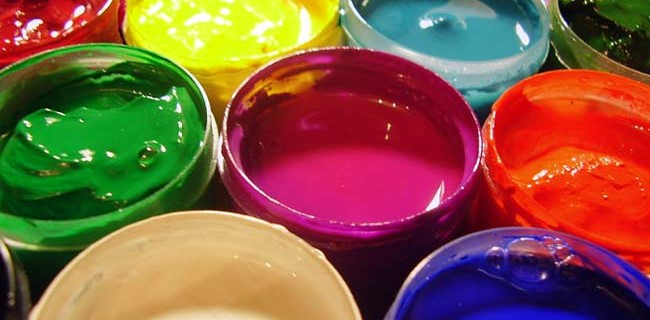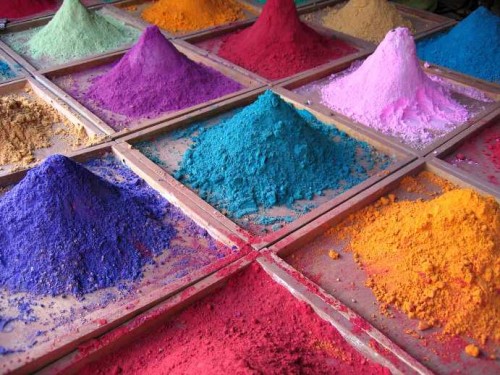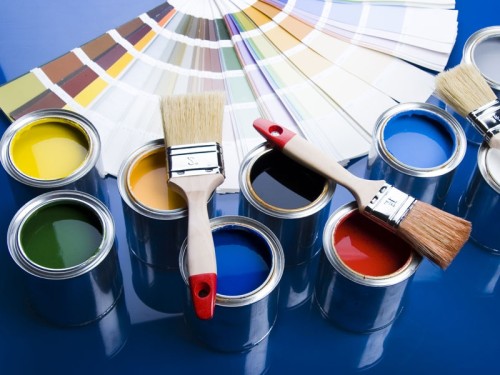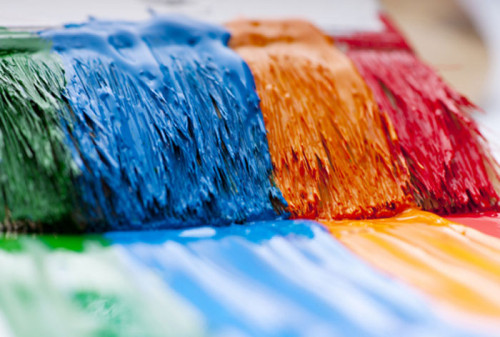
Oil paint: Step-by-step instructions paints and varnishes

Oil paints are one of the most popular means for dyeing various surfaces. Such dyes not only give the necessary shades processed objects, but also protect them from moisture exposure.
Content
Characteristics and composition of oil paints
The two main components of oil paint are a binder and a pigment responsible for the color of the finishing material. The pigment is usually produced from very fine mineral flour, which is not amenable to dissolve, and the binder often protrudes olif. Since the coloring substance is usually heavier than oil, a precipitate is formed at the bottom of the can, so before applying the composition it is necessary to mix it thoroughly.
Oil paint production looks like this:
- part of the coloring agent is divorced in a small amount of oil;
- then the residues of mineral flour are gradually introduced, and the paint is diluted with oil to the desired consistency;
- to improve the quality of this finishing material, it is passed through the paintoter;
- in the dense paint before carrying out finishing work, it is customary to add a certain amount of olifa, about 20-40%.
Olife is a viscous liquid of dark brown. This substance is produced from vegetable or synthetic oils. In the modern market of building materials you can find the olifes of various groups, the greatest popularity of which use oil and alkyd compositions. Alkidal olifes are substances produced from resins modified oils. Oil compositions, in turn, are divided into 3 types: natural, combined and oils oxol. The most qualitative material is the natural olifa, but its cost is noticeably higher than the price of other types of material, therefore, in the industrial production of paints, such an olhor is rarely used.
Most manufacturers sell oil paints in tanks of 0.5-3 liters. The label with the product necessarily prescribes the following information:
- color of the coloring agent;
- consumption of material for 1m² with single-layer and two-layer applies;
- for which surfaces this paint is intended;
- what can breed oil paint.
In construction, oil paints are widely used for decorative surface color, as well as to create a ground layer on wooden parts. You can dilute a similar composition with gasoline, solvent-naphtha, turpentine, kerosene or white-spirited.
The colors of oil paints presented in the modern market of building materials are surprised by their diversity. Among hundreds of various shades, each consumer will certainly find the desired option, and mixing various color gamuts, you can achieve the creation of new tones. The choice of the desired color depends on the designer idea, as well as from the tastes of the consumer. As a rule, it uses dark, deep shades in the outer decoration, whereas for the color of the internal elements are used the lighter and bright gamut. It is worth noting that over time, oil paint flashes slightly in the sun, so the most rich tones are used to dye the outer surfaces. From color paint may also depend on 1 m² area.
Regardless of the oil paint brand, most manufacturers are applied to the labels of their product:
- B - it is possible to dilute with water;
- P - Powder paint;
- B - without volatile substances;
- VD - water-emulsion paint;
- One is organodissess paint.
In addition, if only one substance is used as a pigment, then its name will be spelled out on the label, and not the word "paint".
Nowadays, oil paints are rarely used for the final finish of surfaces, the fault of this definite disadvantages of the material:
- The term of complete drying of oil paint ranges from 6 hours to several days. All this time, the composition highlights a rather unpleasant smell.
- Modern paints are produced on the basis of non-human olifes, which allocate toxic substances into the environment. The finishing color of the inner walls of the oil paint room can harm human health.
- This finishing material does not absolutely transmit air, so the surface under oil paint does not "breathe" - this leads to cracking of the coating.
- Olife, which is part of the material, over the years acquires unpleasant yellowness, which will noticeably spoil the shade of the painted surface.
- Modern alkyd coatings are considered more reliable, durable and elastic, rather than oil paints.
Nevertheless, even despite all the above disadvantages, oil paint still takes great popularity among other finishing materials. The main reason for this is low cost and accessibility, because to afford a similar composition can consumes of completely different intake.
Technical characteristics of oil paints
So as not to be mistaken in the choice of a suitable finishing material, it is important to pay attention to the main technical characteristics of the paint. Consider details these parameters:
- One of the meaningful characteristics of oil paint is the number of film-forming substances in its composition. The mass fraction of these elements should be at least 26% of the total paint. The function of film-forming substances consists in creating a solid impermeable coating on the treated surface. The higher the indicator indicators, the more durable will be the paint. However, the high percentage of film-forming elements reduces the shelf life of the finishing material. In the closed capacitance, the paint is able to be stored for many years, but after printing the packaging, the cans will enter the air, and if not to use the composition of the whole, its residues will turn into a solid lump, unsuitable for further use.
- Another important technical parameter of oil paint is the amount of volatile substances included in its composition. High-quality material, this indicator should not be higher than 10%. Volatile substances are usually toxic and harm human health. They evaporate at temperatures above 20 ° C and have an unpleasant odor, so the painted rooms are taken to air to be fully dried.
- The following technical indicator of the material is considered the degree of peer of paint components. From how small the peer will be, the grain of the treated surface depends. If this indicator is less than 90 microns, then the painted surface will be smooth, with higher indicators the surface will be rough.
- From the level of viscosity of the substance depends on the consumption of oil paint, its turnover and time of frozen. The level of viscosity in quality material ranges from 65 to 140 units. It is also worth noting that the time of drying oil paint should not be more than 2 days.
- Among the quality of oil paint cannot be underestimated and the hardness of the film formed. It is especially important to consider this characteristic if the paint is used to treat external surfaces. The more solid coverage, the longer the paint will last on the surface and the better the material will be protected from the negative impact of the environment.
- Another important parameter of the quality of the material is its hydrophobicity. For most of the compositions used outside buildings, hydrophobicity should be absolute. In the case of paints used to work indoors, this indicator can vary from 0.5 to 1 units.
Features of using oil paints
On average, when painting surfaces with oil paints, the material consumption is 100-150 g per 1m². The main role in the amount of the expendable composition is played by the structure and roughness of the object, for example, wood superbly absorbs any liquid, including paint, so consumption when painting wooden parts may increase several times.
Oil paint is used almost on any surfaces: plastic, concrete, metal, wooden. The composition is often used as a ground coating under the finishing finish. When carrying out painting with oil paints, some subtleties should be taken into account:
- Processing narrow details of window frames, door strapping, etc., there is a risk of staining glass or walls. It will be quite problematic to remove the oil paint, so it is necessary to take care of the protection of those elements that should remain clean. The walls are easiest to cover with a piece of plywood, tin sheet or cardboard, and it is better to stick paper on the glasses. Cut out wide paper stripes, moisten their waterborne waterborne soap and fix over the perimeter of windows. After drying, it will be completely easy to remove the paint.
- In case the glass was fan, remove the paint with the help of the cooked composition. Mix the sodaal chalk and aqueous solution of washing soda, the substance should resemble a paste on the consistency. Apply the composition to the desired places and leave for a while. When the paint becomes soft, erase it with a cloth or paper.
- It is also possible to consider dried paint from the wall. Attach the aluminum foil sheet to the painted surface and join this place with a hot iron. The softened paint can be scraped from the surface with a spatula.
- So that the oil paint moved well onto the metal, it should be pre-watched with vinegar and dry.
- If you want to mix the paint in an open bank, while not risking to stain clothes, use the drill. Put a hole in the capacitance cover, stuck the bent rod into it and secure it with the second end in the cartridge drill. Turn on the device and mix the composition for 1 minute.
- It is easiest to consider paint from hand and body easier for a special solvent, but if you didn't have the desired composition at hand, try to remove the substance with vegetable or animal fat. Carefully wrap the fat into the skin, after which you wash the blurred area with soapy water. It is worth saying that the washing powder also copes well with a similar task.
- If you color a narrow frame and get dirty, fix the thin bar from the tree on the back of the product.
- The window-processed windows and the door is preferably not to close until the coating is completely frozen, but if you still need to do it, put the wramed foil between the painted flaps.
- Metal surfaces will look more accurate if the paint is applied to use not a brush, and the pulverizer.
Operating process with oil paints
Before proceeding with the color of the color of the walls of oil paint, some subtleties should be found:
- In the construction market, paints 2 species are sold: liquid and densely tights. Liquids are compounds that are fully prepared for use, but the densely diluted before applying must be diluted with oil. If instead of the olifa use turpentine, then the treated surface will not be glossy, but matte.
- To the paint sustraine, special substances are added to its composition - sequivates, while their number should not exceed 4% of the total volume of material. In the composition of a light shade, only light sequivations are made to add, and it is not needed at all for the finish coating layer.
- You can get a surface with a matte texture by adding the paint soap into the paint. It must be pre-grated onto the grater and pour water, then heat on the stove and wait for the complete dissolution of the fragments. In a hot soap solution, the paint is gradually introduced, constantly stirring the ingredients. 3 kg of paint, as a rule, use 1 piece of soap.
The process of color consists of such steps:
- First of all, you need to prepare the surface. If it was previously painted with oil paint, then remove the old coating can be removed using a rigid metal brush. If the former paint keeps well enough, it is easier to use a solvent or a special paste.
- The surface that previously was opened with varnish should also be cleaned of its residues. For these purposes, a mixture of ammonia alcohol and chalk is prepared. The resulting paste is applied to the lacquered coating and after a while we wipe the cloth. Water dispersed paint washed the easiest way, for this it is necessary to wet it with warm water and scrape the spatula.
- When the old coating is calculated, the surface of the plastered walls should be treated with a ol'a. To create a resistant and high-quality facing on the walls, a layer of primer is applied, consisting of densely oil paint and olifa. At 100 g, the oils should have from 0.6 to 1.2 kg of paint.
- Before staining the walls of the gap and irregularity is close to oil or semi-wave spacities. The semi-wave composition is prepared according to such a recipe: 20 g of liquid soap are divorced in 200 g of hot animal glue, and then stirring ingredients, 1 kg of olifa, 250 g of turpentar and 50 g of the sequivat are poured. In order to get the composition of the desired consistency, chalk is added to the putty. The resulting means align the surface, and after drying the putty the wall is thoroughly grinding.
- The prepared surface is covered with oil paint. Opening the bank, you need to remove the film from the surface, and the paint itself is pretty stirring. Then you can paint a small fragment of the wall to see what the end result will turn out. In the process of work, the brush is immersed in the paint not completely, but only 1/3 of the length of the pile - so the stained objects will not remain. Working a brush, you need to try to keep it at an angle of 90 ° to the surface, inflicting the composition with wide strokes. The paint is first triturated with horizontal, and then vertical movements.
- It is necessary to apply the coloring composition with a thin layer, and before painting the wall for the second time, you should give the surface to dry completely. If you put a second layer of paint for an uneteble first layer, the coating will be ugly and short-lived.
- If you want to get a very smooth wall, then perform the first layer using a primer composition, leave it until complete drying and pass the shallow sandpaper. Use oil enamel as the last coating layer.
- So that the white oil paint retains its color for a long time, apply it on top of a colorless varnish.
- The surface painted in all rules does not require repainting for 6-7 years.






















